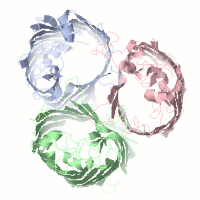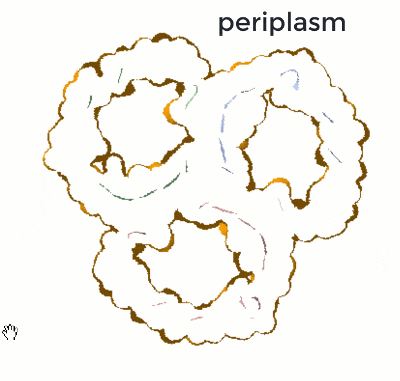Porin
From Proteopedia
Porin or Outer Membrane Proteins (Omps) act as channels which allow passive diffusion of sugars, ions and amino acids. They are beta barrel proteins which traverse the cell membrane. In E. coli they are named according to their genes: C, F, G, etc. (OmpC, OmpF, OmpG). While porins all share a common fold, the detailed makeup and the shape of the inside of the barrel (the channel) determines which molecules pass through the porin and which are retained.Contents |
Function
The function on a porin depends on the size and lining of the channel.
- OprB is a carbohydate-selective porin[1].
- OprF protects Pseudomonas aeruginosa against macrophage clearance[2].
- Maltoporin (LamB) facilitates the diffusion of maltodextrin across the membrane[3].
- Chitoporin (Chitp) facilitates the diffusion of chitooligosaccharides across the outer membrane of some bacteria[4].
- Voltage-Dependent Anion Channel (VDAC) are ion channel Omps found in outer mitochondrial membrane[5]. In Pseudomonas aeruginosa the porin gene products are named OprD, OprE, OprK, OprP, etc. and OpdC, OpdH, etc.
For discussion of specific porins, see
- Mycobacterium tuberculosis ArfA Rv0899 for OmpA type
- Osmoporin OmpC (E. coli)
- OmpF
- Molecular Playground/OmpG
- Molecular Playground/OmpG2
- Osmoporin OmpK36 (K. pneumoniae)
Structure
| |||||||||||
Acknowledgement
The scene showing channels as pseudoatoms is from a page (User:Eric_Martz/Sandbox_19) made by Eric Martz. Eric also helped creating the surface rendition of the channels (technical details here: Image:Tunnels.jvxl).
References
- ↑ Wylie JL, Worobec EA. The OprB porin plays a central role in carbohydrate uptake in Pseudomonas aeruginosa. J Bacteriol. 1995 Jun;177(11):3021-6. PMID:7768797 doi:10.1128/jb.177.11.3021-3026.1995
- ↑ Moussouni M, Berry L, Sipka T, Nguyen-Chi M, Blanc-Potard AB. Pseudomonas aeruginosa OprF plays a role in resistance to macrophage clearance during acute infection. Sci Rep. 2021 Jan 11;11(1):359. PMID:33432030 doi:10.1038/s41598-020-79678-0
- ↑ Van Gelder P, Dumas F, Bartoldus I, Saint N, Prilipov A, Winterhalter M, Wang Y, Philippsen A, Rosenbusch JP, Schirmer T. Sugar transport through maltoporin of Escherichia coli: role of the greasy slide. J Bacteriol. 2002 Jun;184(11):2994-9. PMID:12003940
- ↑ Suginta W, Chumjan W, Mahendran KR, Schulte A, Winterhalter M. Chitoporin from Vibrio harveyi, a channel with exceptional sugar specificity. J Biol Chem. 2013 Apr 19;288(16):11038-46. PMID:23447539 doi:10.1074/jbc.M113.454108
- ↑ Shoshan-Barmatz V, Israelson A, Brdiczka D, Sheu SS. The voltage-dependent anion channel (VDAC): function in intracellular signalling, cell life and cell death. Curr Pharm Des. 2006;12(18):2249-70. PMID:16787253
- ↑ Basle A, Rummel G, Storici P, Rosenbusch JP, Schirmer T. Crystal structure of osmoporin OmpC from E. coli at 2.0 A. J Mol Biol. 2006 Oct 6;362(5):933-42. Epub 2006 Aug 3. PMID:16949612 doi:10.1016/j.jmb.2006.08.002
Proteopedia Page Contributors and Editors (what is this?)
Michal Harel, Karsten Theis, Alexander Berchansky, Joel L. Sussman, Jaime Prilusky



